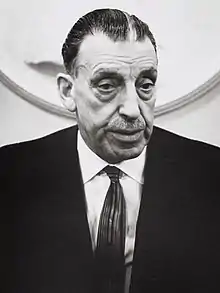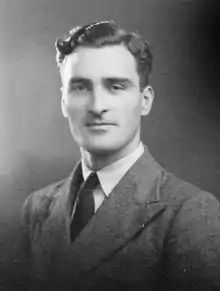| |||||||||||||||||||||||||||||||||||||||||||||||||||||||||||||||||||||||
144 seats in Dáil Éireann[lower-alpha 1] 73 seats needed for a majority | |||||||||||||||||||||||||||||||||||||||||||||||||||||||||||||||||||||||
|---|---|---|---|---|---|---|---|---|---|---|---|---|---|---|---|---|---|---|---|---|---|---|---|---|---|---|---|---|---|---|---|---|---|---|---|---|---|---|---|---|---|---|---|---|---|---|---|---|---|---|---|---|---|---|---|---|---|---|---|---|---|---|---|---|---|---|---|---|---|---|---|
| Turnout | 75.1% | ||||||||||||||||||||||||||||||||||||||||||||||||||||||||||||||||||||||
| |||||||||||||||||||||||||||||||||||||||||||||||||||||||||||||||||||||||
 Percentage of seats gained by each of the three major parties, and number of seats gained by smaller parties and independents. | |||||||||||||||||||||||||||||||||||||||||||||||||||||||||||||||||||||||
| |||||||||||||||||||||||||||||||||||||||||||||||||||||||||||||||||||||||
The 1965 Irish general election to the 18th Dáil was held on Wednesday, 7 April, following the dissolution of the 17th Dáil on 18 March by President Éamon de Valera on the request of Taoiseach Seán Lemass. The general election took place in 38 Dáil constituencies throughout Ireland for 144 seats in Dáil Éireann, the house of representatives of the Oireachtas. The governing Fianna Fáil saw a slight increase, though did not obtain a majority.
The 18th Dáil met at Leinster House on 21 April to nominate the Taoiseach for appointment by the president and to approve the appointment of a new government of Ireland. Lemass was re-appointed Taoiseach, forming the 11th Government of Ireland, a single-party minority Fianna Fáil government.
Campaign
The general election of 1965 was caused by the ruling Fianna Fáil party's failure to gain a seat in a by-election. The success of Eileen Desmond of the Labour Party in Cork Mid in holding a seat previously held by her husband Dan Desmond, led to an unacceptable mathematical situation with regard to the government's majority. The Taoiseach, Seán Lemass immediately dissolved the Dáil and the campaign began in earnest.
Fianna Fáil ran its campaign on its record in government. Over the last number of years the economy had seen a huge improvement and the party played up on its record in government. The party also played up heavily on the personality of the party leader with the slogan "Let Lemass Lead On". Fine Gael put forward a comprehensive manifesto, which included the establishment of a government department concerned with economic planning. However, the older, conservative members of the party did not warm to the new turn the party was taking.
Television and radio
This was the first Irish general election to be covered on television by state broadcaster RTÉ, which had formed on 31 December 1961. Election Newsroom was broadcast live on Telefís Éireann from their Donnybrook studios in Dublin, presented by John O'Donoghue with analysis provided by John Healy (The Irish Times), John O'Sullivan (The Cork Examiner), Garret FitzGerald and Professor Basil Chubb. Cameras were present in four count centres: Bolton Street (Dublin), Wexford, Cork and Monaghan. The GPO provided direct links as results were announced. Raidió Éireann provided special coverage from 3 pm on the day of the count due to the coverage on Telefís Éireann. It was a new approach to election coverage on the state's radio service, which began broadcasting in 1926.[3]
Result
| Election to the 18th Dáil – 7 April 1965[4][5][6][7] | ||||||||
|---|---|---|---|---|---|---|---|---|
 | ||||||||
| Party | Leader | Seats | ± | % of seats |
First pref. votes |
% FPv | ±% | |
| Fianna Fáil | Seán Lemass | 72 | +2 | 50.0 | 597,414 | 47.7 | +3.9 | |
| Fine Gael | James Dillon | 47 | 0 | 32.6 | 427,081 | 34.1 | +2.1 | |
| Labour | Brendan Corish | 22[lower-alpha 1] | +6 | 15.3 | 192,740 | 15.4 | +3.8 | |
| Clann na Poblachta | Seán MacBride[lower-alpha 2] | 1 | 0 | 0.7 | 9,427 | 0.8 | –0.3 | |
| Irish Workers' Party | Michael O'Riordan | 0 | 0 | 0 | 183 | 0.0 | 0 | |
| Independent | N/A | 2 | –4 | 1.4 | 26,277 | 2.1 | –3.5 | |
| Spoilt votes | 11,544 | — | — | |||||
| Total | 144[lower-alpha 1] | 0 | 100 | 1,264,666 | 100 | — | ||
| Electorate/Turnout | 1,683,019 | 75.1% | — | |||||
Voting summary
Seats summary
Government formation and aftermath
Fianna Fáil formed the 11th Government of Ireland, a single-party government led by Seán Lemass as Taoiseach. Lemass had been in office since 1959.
James Dillon resigned as leader of Fine Gael immediately after the result was announced.
In November 1966, Lemass resigned as Fianna Fáil leader and Taoiseach, and was succeeded in both positions by Jack Lynch, who formed the 12th Government of Ireland.
Changes in membership
First time TDs
Re-elected TDs
Outgoing TDs
- Gerald Bartley (Retired)
- Seán Brady (Lost seat)
- Robert Briscoe (Retired)
- Dan Breen (Retired)
- Joseph Blowick (Retired)
- John Moher (Lost seat)
- Denis J. O'Sullivan (Lost seat)
- James Ryan (Retired)
- Eugene Timmons (Lost seat)
See also
Notes
- 1 2 3 4 Including Patrick Hogan (Lab), returned automatically for Clare as outgoing Ceann Comhairle, under Art. 16.6 of the Constitution and the Electoral Act 1963.[1][2]
- ↑ After the election, while Seán MacBride was leader of Clann na Poblachta, John Tully became leader and the sole member of the parliamentary party.
References
- ↑ Electoral Act 1963, s. 14: Re-election of outgoing Ceann Comhairle (No. 19 of 1963, s. 14). Enacted on 12 July 1963. Act of the Oireachtas. Retrieved from Irish Statute Book.
- ↑ "18th Dáil 1965: Clare". ElectionsIreland.org. Retrieved 14 July 2022.
- ↑ "RTÉ COVERAGE OF GENERAL ELECTIONS – 1965 GENERAL ELECTION". RTÉ Libraries and Archives. Archived from the original on 4 September 2011. Retrieved 20 September 2011.
- ↑ "Election results and transfer of votes in general election (April, 1965) for eighteenth Dáil and bye-elections to seventeenth Dáil (1961–1965)" (PDF). Houses of the Oireachtas. Dublin Stationery Office. March 1966. Retrieved 17 July 2022.
- ↑ "18th Dáil 1965 General Election". ElectionsIreland.org. Archived from the original on 30 November 2010. Retrieved 31 May 2009.
- ↑ "Dáil elections since 1918". ARK Northern Ireland. Archived from the original on 27 November 2020. Retrieved 31 May 2009.
- ↑ Nohlen, Dieter; Stöver, Philip (2010). Elections in Europe: A data handbook. pp. 1009–1017. ISBN 978-3-8329-5609-7.



